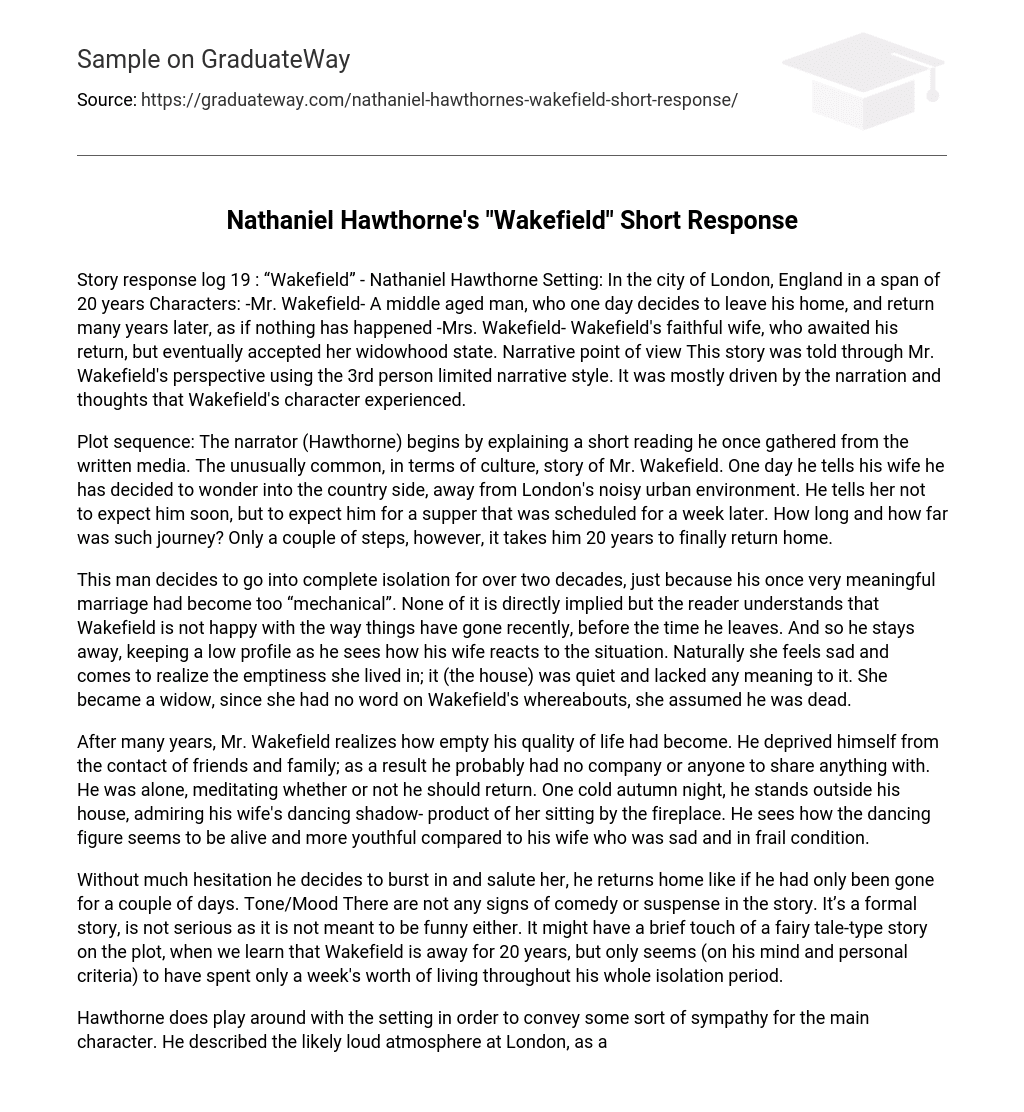Story response log 19 : “Wakefield” – Nathaniel Hawthorne Setting: In the city of London, England in a span of 20 years Characters: -Mr. Wakefield- A middle aged man, who one day decides to leave his home, and return many years later, as if nothing has happened -Mrs. Wakefield- Wakefield’s faithful wife, who awaited his return, but eventually accepted her widowhood state. Narrative point of view This story was told through Mr. Wakefield’s perspective using the 3rd person limited narrative style. It was mostly driven by the narration and thoughts that Wakefield’s character experienced.
Plot sequence: The narrator (Hawthorne) begins by explaining a short reading he once gathered from the written media. The unusually common, in terms of culture, story of Mr. Wakefield. One day he tells his wife he has decided to wonder into the country side, away from London’s noisy urban environment. He tells her not to expect him soon, but to expect him for a supper that was scheduled for a week later. How long and how far was such journey? Only a couple of steps, however, it takes him 20 years to finally return home.
This man decides to go into complete isolation for over two decades, just because his once very meaningful marriage had become too “mechanical”. None of it is directly implied but the reader understands that Wakefield is not happy with the way things have gone recently, before the time he leaves. And so he stays away, keeping a low profile as he sees how his wife reacts to the situation. Naturally she feels sad and comes to realize the emptiness she lived in; it (the house) was quiet and lacked any meaning to it. She became a widow, since she had no word on Wakefield’s whereabouts, she assumed he was dead.
After many years, Mr. Wakefield realizes how empty his quality of life had become. He deprived himself from the contact of friends and family; as a result he probably had no company or anyone to share anything with. He was alone, meditating whether or not he should return. One cold autumn night, he stands outside his house, admiring his wife’s dancing shadow- product of her sitting by the fireplace. He sees how the dancing figure seems to be alive and more youthful compared to his wife who was sad and in frail condition.
Without much hesitation he decides to burst in and salute her, he returns home like if he had only been gone for a couple of days. Tone/Mood There are not any signs of comedy or suspense in the story. It’s a formal story, is not serious as it is not meant to be funny either. It might have a brief touch of a fairy tale-type story on the plot, when we learn that Wakefield is away for 20 years, but only seems (on his mind and personal criteria) to have spent only a week’s worth of living throughout his whole isolation period.
Hawthorne does play around with the setting in order to convey some sort of sympathy for the main character. He described the likely loud atmosphere at London, as a reason for Wakefield’s “trip” into the country. From then on, the reader wonders why he decides do live under the shadows, away from people, in his apartment located across from his home. One might hate him for doing that in order to test his wife, but might not hate him to the extent where the readers wish to crucify him.
Likewise, Hawthorne used the cold and light rainy autumn night to convey Wakefield’s miserable state. Here we see how the main character finally accepts what he has been missing for too long, the love and affection of home. Themes: 1. The underestimated value of family bonds- there is a phrased, “you never know what you have until it’s gone”, that perfectly describes the whole idea behind the story. Wakefield left his home and wife because he thought that they had lost any meaning or importance for him.
But is not until the time, on that cold night, where he realizes he might as well be dead, that Wakefield sees the importance of his wife and the meaningful role she has in his life. 2. Self-realization/life lessons- if it wasn’t for the whole isolation experiment, Wakefield might have never had the chance to learn to appreciate his life for what it truly was. This message is directly send out to the reader in order to analyze what they have been missing. Decision Hawthorne might have tried to illustrate the idea of pure thinking. Isolationism plays a big part in the story.
It seems that most people find any sort of meaningful connection to the universe, or come to powerful and enlightening realization, when they go into a complete isolation. One might not go and put Wakefield’s model into practice, but it’s clear that this story tries to illustrate the importance of meditating. Further discussion- This was a rather interesting story, it reminded of Irving’s “Rip Van Winkle”. In the part where Wakefield’s also seems to experience 20 years in a relatively short period of time. But, unlike Van Winkle, Wakefield returns with an enlightened view about the life he shares with his wife.





